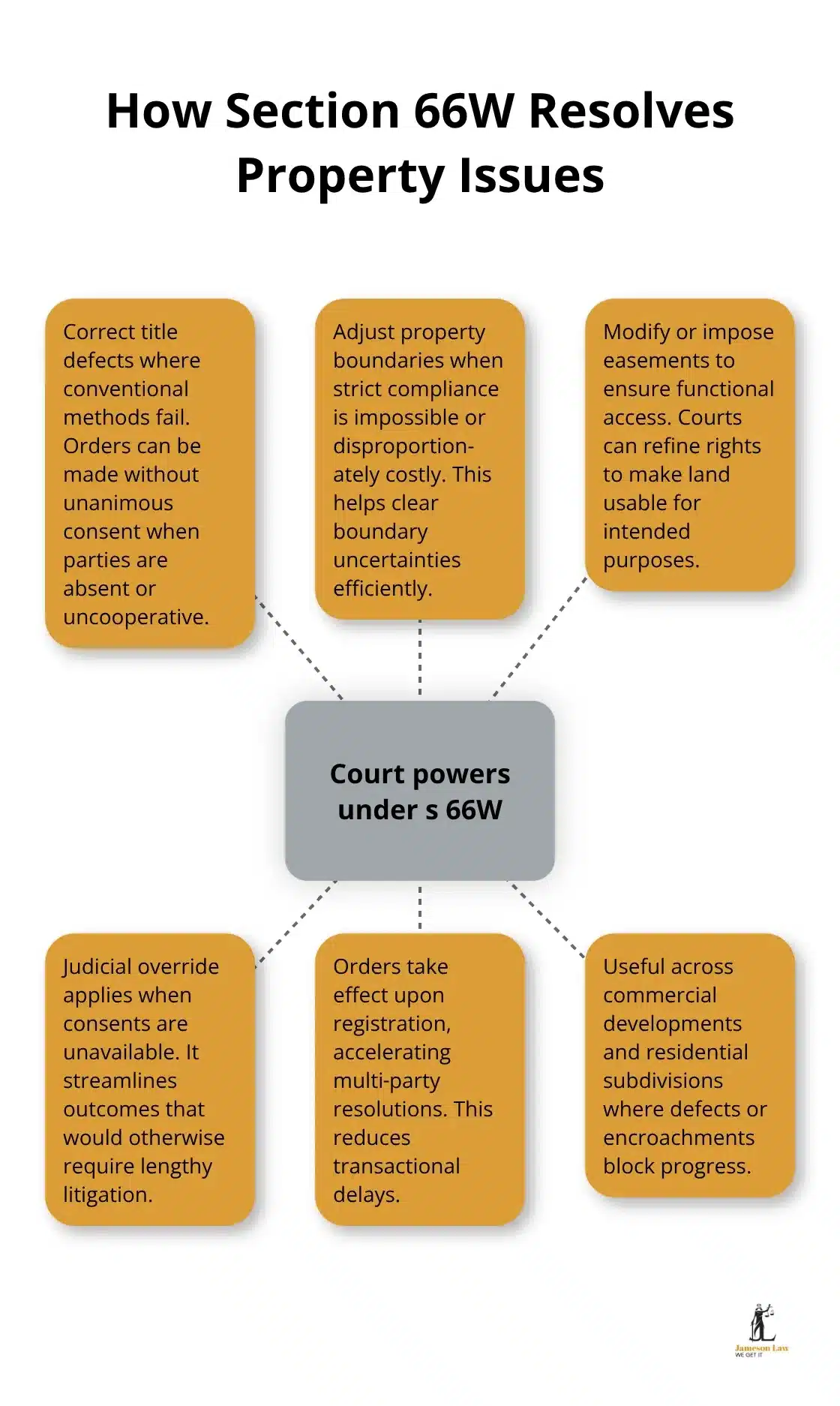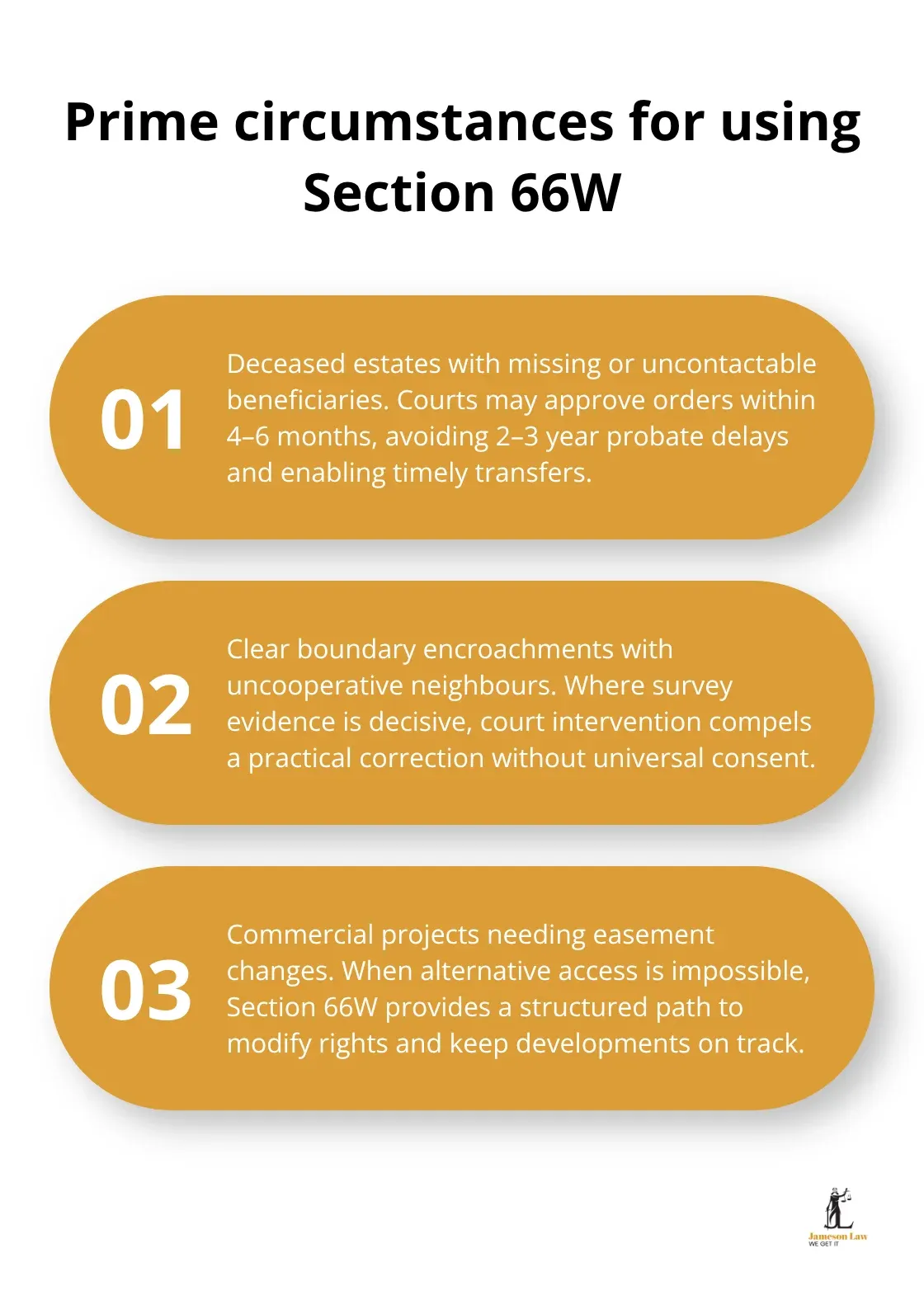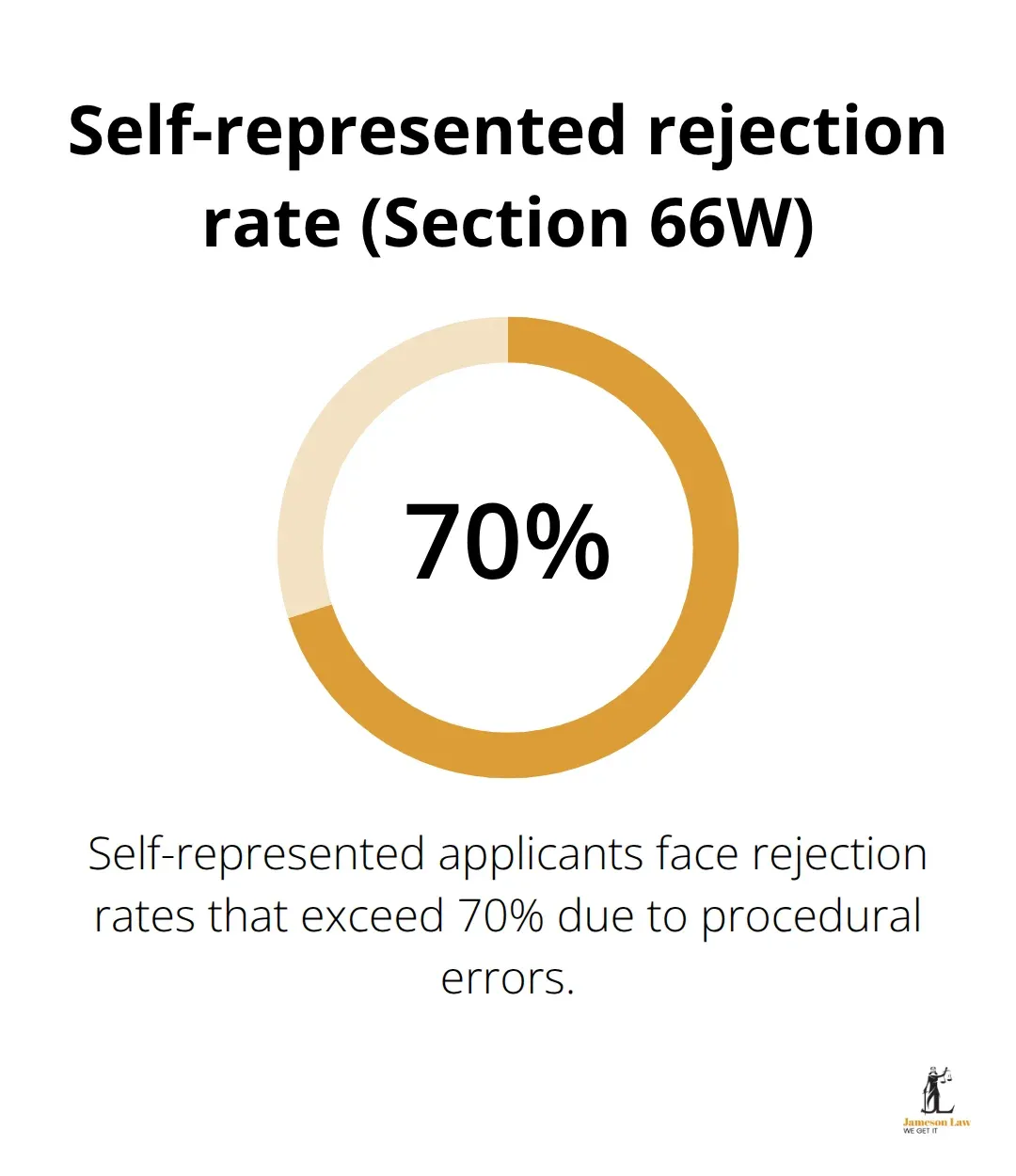Section 66W of the Conveyancing Act 1919 provides property owners with a powerful legal mechanism to resolve boundary disputes and title defects. This provision allows courts to make orders that can effectively cure certain property law issues.
We at Jameson Law regularly guide clients through this complex process. Understanding when and how to apply Section 66W can save property owners significant time and legal costs.
What Does Section 66W Actually Do?
The Core Function of Section 66W
Section 66W empowers NSW courts to make orders that correct property title defects and resolve boundary uncertainties without unanimous agreement from all affected parties. The provision targets situations where traditional methods fail due to absent consents, deceased parties, or uncooperative landowners. Courts can order title corrections, boundary adjustments, and easement modifications when strict compliance with standard procedures becomes impossible or unreasonably expensive.
The section operates as a judicial override mechanism. Property owners who face title clouds that would otherwise require costly litigation or prevent property transactions can petition the court for direct intervention. Property disputes involving title defects benefit from Section 66W applications, particularly valuable for commercial developments and residential subdivisions.

Mandatory Requirements and Evidence Standards
Courts require substantial evidence before they grant Section 66W orders. Applicants must demonstrate that the proposed order serves the interests of justice, that affected parties have received proper notice, and that alternative remedies are inadequate or impractical. The application must include detailed survey plans, title searches that date back at least 30 years, and sworn affidavits from qualified surveyors.
Financial compensation often forms part of Section 66W orders. Courts typically require applicants to deposit funds that cover potential damages to affected parties, with amounts that range from $10,000 to $500,000 depending on property values and dispute complexity. The evidence threshold is deliberately high because Section 66W orders can override property rights without owner consent.
How Section 66W Differs From Standard Conveyancing
Unlike voluntary property transfers that require all parties to agree and sign contracts, Section 66W creates court-imposed changes to property rights. Standard methods rely on mutual consent and follow prescribed statutory procedures, while Section 66W bypasses these requirements when compliance becomes impossible. The provision also differs from adverse possession claims because Section 66W applications can succeed within months of submission.
Section 66W orders bind all parties immediately upon court registration, unlike settlement agreements that depend on voluntary compliance. This effect makes the provision particularly powerful for multi-party disputes where unanimous agreement proves impossible.
With these foundational elements established, the next step involves understanding the specific situations where Section 66W applications prove most effective and the detailed process required to submit a successful application.
When Should You Use Section 66W
Prime Circumstances for Section 66W Applications
Section 66W applications work best in three specific situations. First, when deceased estate executors cannot locate all beneficiaries to obtain consent for property transfers, courts typically approve Section 66W orders within 4-6 months compared to 2-3 years for traditional probate resolution. Second, boundary disputes where survey evidence clearly shows encroachments but affected neighbours refuse to cooperate benefit significantly from this provision. Third, commercial developments that require easement modifications face significant challenges, particularly when alternative access routes prove impossible.

Property owners should avoid Section 66W applications when voluntary agreements remain possible or when evidence quality falls below court standards. The provision becomes counterproductive for minor boundary adjustments under 2 metres or disputes that involve less than $50,000 in property value due to disproportionate legal costs.
Application Process Requirements
Submit Section 66W applications through the NSW Supreme Court with associated filing fees for standard cases. Applications require current survey plans that registered surveyors prepare, historical title searches that span 30 years minimum, and detailed affidavits that explain why conventional methods failed. Courts mandate personal service of documents on all affected parties at least 28 days before hearings (registered mail proves insufficient for proper notice).
Documentation Standards and Success Factors
Successful applications typically include compensation proposals between $5,000-$100,000 depending on property impact, engineering reports for structural changes, and evidence of genuine attempts at voluntary resolution. Professional legal representation becomes essential given the technical requirements and complexity of these applications for self-represented applicants.
The complexity of these requirements and the potential for costly mistakes make understanding common pitfalls and legal considerations vital before you proceed with any Section 66W application.
Common Pitfalls and Legal Considerations
Critical Documentation Errors That Courts Reject
Survey plans that lack current certification represent the most common reason for Section 66W application failures. Courts reject applications with survey plans older than 12 months or those that unregistered surveyors prepare. The NSW Supreme Court dismissed applications in 2023 due to inadequate survey documentation alone. Affidavits that fail to specify exact attempts at voluntary resolution also trigger immediate rejections.
Courts demand detailed records of correspondence, meeting dates, and specific reasons why negotiations failed. Generic statements about uncooperative parties prove insufficient for court approval. Applications must demonstrate genuine efforts to resolve disputes through conventional means before courts will consider Section 66W intervention.
Service Requirements That Destroy Applications
Service of process errors destroy otherwise strong applications. Personal service requirements mean that you cannot leave documents with family members, post notices on properties, or send registered mail to satisfy court standards. Courts require proof that defendants personally received documents at least 28 days before hearings.
Missing this deadline forces complete resubmission with new filing fees and delays that typically extend 3-4 months. The Supreme Court maintains strict standards because Section 66W orders can override property rights without owner consent (making proper notice essential for procedural fairness).
Financial Security and Compensation Mistakes
Courts reject applications without adequate compensation deposits. The required amount typically equals a percentage of affected property values, with minimum deposits of $25,000 for residential properties and $100,000 for commercial applications. Applicants who underestimate compensation requirements face automatic dismissal.
Financial guarantees must accompany initial applications rather than follow later submissions. Courts view inadequate security deposits as evidence that applicants have not properly assessed the impact on affected parties or the genuine necessity of their proposed orders.
Timing Errors and Procedural Deadlines
The Supreme Court rejects applications filed within 6 months of property purchases, viewing such timing as evidence of rushed decisions rather than genuine necessity. Applications must include all supporting evidence at submission because courts refuse late additions of survey reports, engineering assessments, or financial guarantees.
The 21-day response period for objections becomes critical because unopposed applications receive faster consideration. Contested matters can extend beyond 12 months with legal costs that exceed $150,000 when procedural errors force multiple resubmissions.
Final Thoughts
Section 66W of the Conveyancing Act 1919 offers property owners a judicial solution when conventional methods fail, but success requires meticulous preparation and strict adherence to court requirements. The provision works best for boundary disputes with clear survey evidence, deceased estate complications, and commercial developments that need easement modifications. Professional legal assistance becomes essential given the technical documentation standards, service requirements, and financial security deposits that courts mandate.
Self-represented applicants face rejection rates that exceed 70% due to procedural errors that proper guidance could have prevented. Property owners must register court orders with NSW Land Registry Services within 30 days after successful Section 66W applications and notify all affected parties of the changes. The orders become active immediately upon registration (creating permanent alterations to property rights and boundaries).

We at Jameson Law guide clients through every aspect of Section 66W applications, from initial assessment through court registration. Our conveyancing expertise helps property owners navigate these complex procedures while avoiding costly mistakes that delay resolution and increase legal expenses.













